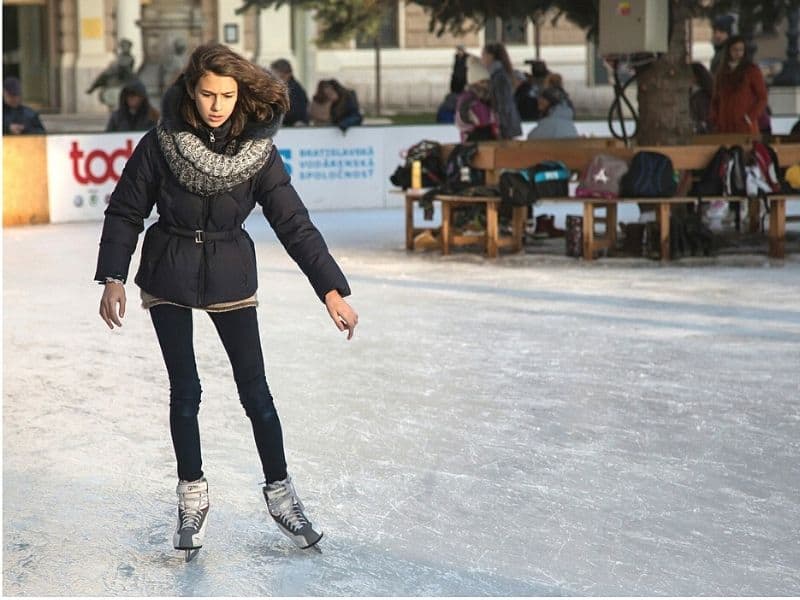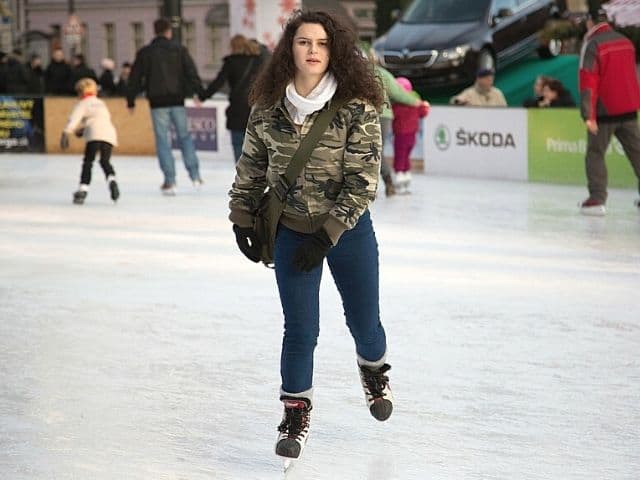Many people find ice skating intimidating because they think that it will be hard to learn.
And while it’s true that some skaters might pick it up faster or easier than others, especially if the person is more athletically inclined.
Anyone, including those not so athletic inclined, can learn to ice skate.
As ice skating is not that hard to learn, once you’ve mastered a few basic tips and techniques.
12 Tips that Makes Learning to Ice Skate Easier
1. Make Sure Your Ice Skates Fit Properly
While this might seem like common sense, many ice skating beginners make the mistake of either skating with ice skates that do not fit properly or wearing the skates to lose.
Which makes learning how to ice skate much harder, as the skates will not provide enough support.
One of the easiest ways to tell if your skates are too loose, whether from improper sizing or from an improper lace-up is that they will feel very wobbly and will constantly be collapsing in on your ankles or leaning out.
So before stepping out onto the ice, make sure your ice skates fit comfortably but also snuggly and provide enough support for you to stand up straight without struggling.
2. Warm Up and Stretch First
While warming up and stretching are important no matter what sport you’re participating in, it’s especially important in cold weather sports.
As muscles and tendons are much more likely to be cold and stiff in cold weather.
And cold muscles and tendons are far more prone to injury than ones that have been properly warmed up.
So to help prevent injury while ice skating, it’s important to stretch beforehand and to take it easy at first until your muscles and tendons have had a chance to warm up.
Best Stretches for Ice Skating
- Front Lunges
- Side Lunges
- Arm Swings
- Front and Back Side to Side Leg Swings
- Leg Curls
- Ankle Rotations
- Nech Stretch
- Calf Muscle Stretch
- Hamstring Stretch
- Back Rotation Stretch
- Lower Back Stretch
3. Learn to Fall
Falling is just a part of ice skating, especially when your first learning how.
So it’s important you learn how to properly fall, to help minimize the impact of falling and reduce the likelihood of injury.
And the best way to learn how to fall properly is to practice falling on purpose in a controlled fashion.
By bending your knees and squatting into a dip position.
Because the lower you can get your body to the ice before falling, the shorter the distance you will have to fall, which will help to minimize and reduce its impact and severity.
Once in the squatted position you then want to land on your butt ideally or your knees if you can’t keep from falling forward and keep your arms and legs as close to your body as possible.
While attempting to roll in the natural direction of the fall to reduce the impact, making sure to always protect your head.
And while these techniques will not always be possible, especially if a fall catches you off guard.
The main thing to focus on is getting as low to the ground as possible before hitting the ice and trying to naturally roll into the fall to avoid hard or blunt impacts.
4. Know-How to Get Back Up
When learning how to ice skate, it’s also really important to learn how to properly get back up, once you’ve fallen.
Luckily though getting back up can be accomplished in three easy steps.
- Get to the crawl position with your hands and knees on the ice.
- Then bring one knee up so the skate underneath is level with the ice (Doesn’t matter which knee, just use whichever feels more comfortable.)
- Then place both hands on top of that knee and use your arms to push yourself up into a standing position.
5. Maintain an Athletic Position with Your Knees Bent
When learning how to ice skate, you want to maintain an athletic position with your knees bent, feet shoulder-width apart, chest up, and shoulders parallel with the ice.
As the athletic position will help to keep your body weight centered over the skates, which will help with control and balance.
Because leaning too far forward or backward will cause your body weight to shift forward or backward, which will make it much more difficult to maintain balance.
Also, standing straight up while skating, will also make it harder to maintain balance, which is why you always want to keep your knees bent to maintain a lower center of gravity.
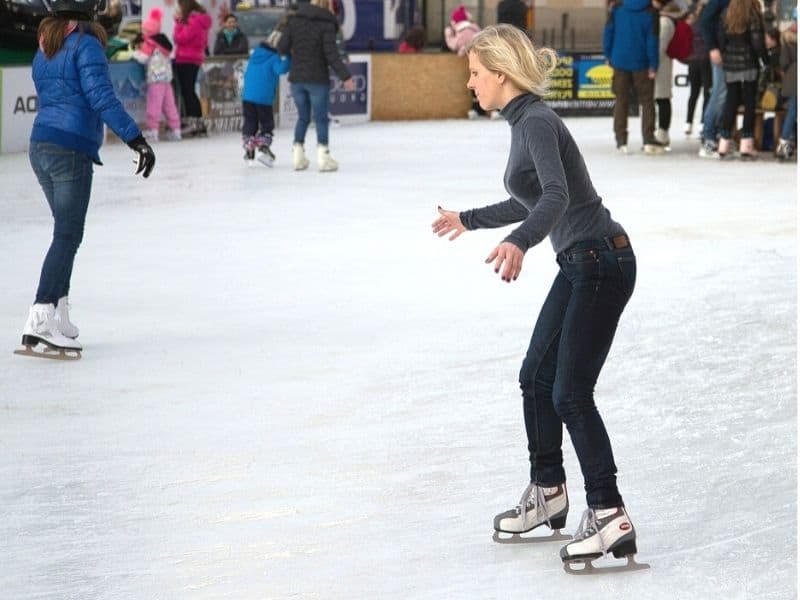
6. Putting Your Arms Out and Grabbing Your Knees Can Keep You From Falling
When learning to ice skate, falling is just part of the process, however, there is a technique you can use to regain your balance and keep yourself from falling.
As most ice skating falls, especially when first learning to skate, result from loss of balance.
So if you feel like you’re starting to fall, you want to work to regain your balance by immediately placing your arms out in front of you and then slightly squatting down while grabbing your knees to regain balance.
And while this technique will not always work, as sometimes balance recovery is just not possible, it will go a long way to help keep your butt off the ice.
7. Use Your Arms for Balance
Your arms are one of the best tools you have to maintain balance while learning to skate.
As they can really help to keep your balance by counterbalancing your body and movements while ice skating.
So when learning to ice skate it’s important to keep your arms out from your sides and slightly in front of your body to help maintain balance.
8. Don’t Look Down
When learning to ice skate a natural inclination will be to look down at your ice skate to make sure they are doing what they are supposed to be doing.
But as is the case with most sports, ice skating is more feel than anything else, and looking down at your skates will not help to improve your technique or ability.
In fact, looking down while ice skating can actually be a hindrance and make learning to skate much more challenging and difficult.
As looking down while skating, can cause you to lose your balance.
Because the moment you look down at your ice skates, you’ve lost your point of reference for balance, which is the ice itself and the horizon in front of you.
In addition, looking down at your ice skates while skating will also greatly increases your chances for a collision with either another skater or an obstacle in front of you.
Because if you’re looking down at your skates, you’re not looking at where you’re going.
So when learning to ice skate always keep your head up and looking forward and trust that your skates are doing what they are supposed to be doing.
9. Learn to March Before You Skate
While it might seem a little odd at first, marching is actually a great way to learn how to skate, as marching on the ice has several unique benefits.
To begin with, marching is generally easy to pick up for most new skaters, which gives a much-needed boost of confidence while your first learning to skate.
Second marching on the ice allows you to get comfortable with lifting one foot off the ice, while still maintaining balance with the other foot still on the ice.
And third marching on the ice allows you to focus on maintaining a strong balanced core while skating, which will really come in handy when learning more advanced techniques of ice skating.
To march on the ice, all you need to do is lift up your knees in a walking motion while focussing on staying steady and still.
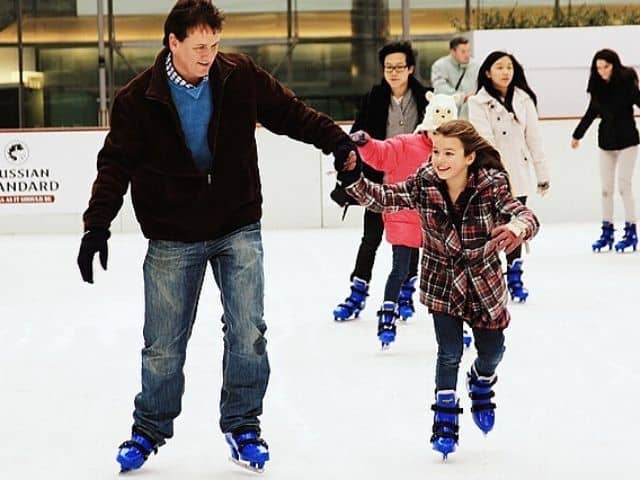
10. Skating is Not Running
Another important thing to keep in mind while learning how to ice skate is that skating is not running.
As the motion used to propel yourself forward while running is very different from the motion used while ice skating.
Because while running uses a kicking motion, where each alternating leg is pushing off from directly behind the body.
Ice skating uses more of a side to side motion, where each alternating leg moves backward as well as outward.
In order to provide the necessary resistance for the skate’s blade to grab the ice.
How to Propel Yourself Forward While Ice Skating
- Place your skates parallel to one another shoulder-width apart.
- Then turn one skate outward with the skate rolled slightly inward, so you’re using the inside edge of the blade.
- While keeping most of your weight on the ice skate still pointed straight.
- Then you want to rock your ankle backward and push off the toe portion of the skate on the inside edge.
- And finish by bringing both skates back together again in a parallel position shoulder-width apart to transition to gliding.
Also, while you will more than likely have a leg you feel more comfortable using to push off from, it’s important to practice this technique using alternating legs.
As this is the same general motion you will use while striding and continuing to move forward, while ice skating.
11. Swizzle to Get the Feel for Ice Skating
Once you’re moving and gliding on the ice, a great way to practice the motions of skating without having to lift your skates from ice is swizzling.
As swizzling allows you to practice the general movements and motions of ice skating, while still keeping both feet on the ice, which greatly reducing the likelihood of falling.
But what exactly is swizzling?
Swizzling is the act of moving your feet in and out in the shape of an hourglass, as you glide along the ice, which is accomplished by first pointing your toes outwards to pull your skates apart and then pointing them inwards to bring your skates back together and then repeating this process over and over again.
Which should leave a trail of hourglass shapes in the ice behind you, if you’re doing it correctly.
12. Ice Skating is Just Striding and Gliding
Once you’ve mastered all the above techniques and tips, the only thing left to do is to put it all together, with striding and gliding, which is really all ice skating is.
By pivoting off one skate (discussed in tip 10) to get yourself going and then alternating between striding and gliding to propel yourself around the ice skating rink.
By first striding, which can be accomplished by moving the skate to the side and backward while pushing off the inside edge of the blade, and then pushing off with the opposing skate in the same manner, until you reach the desired speed.
And then gliding along the ice before switching back to striding again, once the speed and energy have been used up from the previous striding.
Bonus Tip: How to Stop!
If you’re thinking we left one pretty critical tip, off our list, which is how to stop.
Not to worry, as we’ve included one last bonus tip, which is all about how to stop while ice skating.
There are 4 main ways to stop while ice skating, which include the snowplow stop, the T stop, the hockey stop, and the tango stop, which we describe in great detail below.
Snowplow Stop
The first and easiest way to stop while ice skating is the snowplow stop.
Which is accomplished by placing your arms outwards and slightly in front of you for balance and then pushing your skates out into a V-shape position with your toes pointed inward, while keeping your skates shoulder-width apart until you come to a stop.
T Stop
To perform a T stop while ice skating, you want to start off with a one-foot glide.
And then place your opposing skate behind and perpendicular to the gliding skate to form a T shape, placing downward pressure on the outside edge of the back skate’s blade until coming to a stop.
Hockey Stop
The hockey stop is a more challenging stop to master while ice skating but it can be accomplished by beginner ice skaters with enough practice.
To perform a hockey stop while ice skating, you want to start out with a two foot glide.
And then bend your knees and bring your skates sideways and together, while leaning slightly backward away from the forward motion and checking your hips to the side at the same time.
The hockey stop can take a lot of practice to get just right, as it is a very abrupt and aggressive stop compared to the snowplow and T stop.
Tango Stop
The tango stop is a more artistic way to stop while ice skating and is most commonly used during figure skating where points are awarded for style and artistic flair.
To perform a tango stop, drive your back foot forwards by pressing down at the knee and ankle on the outside edge of the skate while bending slightly to stop. And then slowly raising with outstretched arms to complete the move.
Keep in mind though, that this type of ice skating stop, should only be performed by more experienced ice skaters.
Because like the hockey stop, the tango stop can be challenging to pull off successfully.
Want to know how much ice skating and figure skating costs? If so, check out our article “Is Ice Skating Expensive? Answered With Cost Breakdown“.
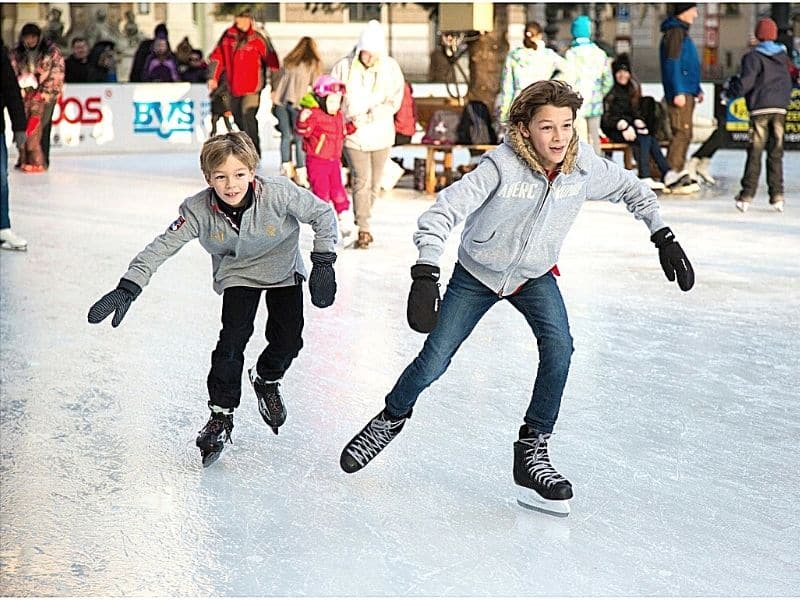
How Long Does it Take to Learn to Ice Skate?
How long it takes to learn to ice skate can vary greatly from person to person depending on their level of athleticism and fitness but, in general, it will usually take the average person anywhere from a few hours to as many as 4 or 5 hours to learn the basics of ice skating.
Which include maintaining balance while on the ice, learning to push off and stop, striding, and gliding as well as basic and simple turning.
This means that the average person can usually learn the basics of ice skating by spending an afternoon on the ice.
However, it’s important to keep in mind that everyone learns at a different pace, so if it takes you a little longer, don’t get frustrated, and just keep at it.
Because I have never met someone that couldn’t learn to ice skate, that really wanted to, as long as they kept practicing and didn’t quit.
Can I Teach Myself How to Ice Skate?
While ice skating lessons can greatly shorten the learning curve and keep you from getting into bad habits, it is entirely possible to learn to ice skate by yourself.
Especially in the world of Youtube, which has instructional videos on pretty much everything, including how to ice skate.
In fact, two of the most popular how-to ice skate videos on Youtube are included and embedded right in this article.
But if you find yourself struggling, don’t be afraid to reach out and get some help.
As just about every local ice skating rink has classes taught by knowledgeable instructors, on everything from the basics to more advanced techniques.
Is Ice Skating Dangerous for Beginners?
Ice skating is a popular winter sport that the whole family can enjoy but just like all sports, it’s not without its risks or dangers.
Because while ice skating is generally pretty safe, it is possible to sustain a variety of injuries while ice skating, including ankle sprains, hand and wrist injuries, and even fractures and head injuries.
As more than 50,000 people are injured each year while ice skating, with many of them being beginners.
However, it’s important to keep the risk of injury and level of danger in perspective.
As it’s unlikely you will sustain an injury while learning how to ice skate as a beginner and if you do it will more than likely be minor in nature.
Because while around 50,000 people do sustain injuries each year from ice skating that is out of the 10 million people who participate in the sport each year.
For more information on the dangers of ice skating, as well as, information on how to minimize and reduce those dangers, check out our article “How Dangerous is Ice Skating? (Most Common Injuries)“.
How Hard is it to Learn to Ice Skate as an Adult?
While it might be true that younger ice skaters tend to bounce back a little quicker from a fall compared to older ones while learning how to skate.
There is no age limit when it comes to learning how to ice skate, as both young and old can learn to skate and participate in the sport.
As it’s not any harder for an adult to learn how to ice skate than it is for a child.
I will say though that children do have one significant advantage over adults when learning how to ice skate, which is that children are far less concerned about looking foolish or making mistakes.
Which can help to greatly reduce the learning curve for children while learning how to ice skate compared to adults.
As children are much more likely to just get out there skate without a care in the world.
While adults tend to be much more timid and cautious, so as not to look foolish, which can slow their progress while learning to ice skate.
Can You Learn to Ice Skate at 50?
There is no age limit when it comes to learning how to ice skate.
So if you’re 50 and worrying about whether it’s too late to learn how to ice skate, just know that more and more seniors every year who are 65 years and older are taking up the sport.
Which should give you all the confidence you need to get out on the ice and learn how to skate.
As you are more than likely 20 years younger than the average senior learning how to ice skate.
To see other winter sports you can do during the winter and while camping, check out our article “18 Fun Things to Do While Winter Camping“.
Sources
Best Stretches for Ice Skating – Barklay Physical Therapy
Number of Ice Skating Injuries Each Year – Rothman Orthopedics

